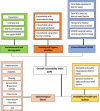Role of multiresolution vulnerability indices in COVID-19 spread in India: a Bayesian model-based analysis
- PMID: 36396323
- PMCID: PMC9676421
- DOI: 10.1136/bmjopen-2021-056292
Role of multiresolution vulnerability indices in COVID-19 spread in India: a Bayesian model-based analysis
Abstract
Objectives: COVID-19 has differentially affected countries, with health infrastructure and other related vulnerability indicators playing a role in determining the extent of its spread. Vulnerability of a geographical region to COVID-19 has been a topic of interest, particularly in low-income and middle-income countries like India to assess its multifactorial impact on incidence, prevalence or mortality. This study aims to construct a statistical analysis pipeline to compute such vulnerability indices and investigate their association with metrics of the pandemic growth.
Design: Using publicly reported observational socioeconomic, demographic, health-based and epidemiological data from Indian national surveys, we compute contextual COVID-19 Vulnerability Indices (cVIs) across multiple thematic resolutions for different geographical and spatial administrative regions. These cVIs are then used in Bayesian regression models to assess their impact on indicators of the spread of COVID-19.
Setting: This study uses district-level indicators and case counts data for the state of Odisha, India.
Primary outcome measure: We use instantaneous R (temporal average of estimated time-varying reproduction number for COVID-19) as the primary outcome variable in our models.
Results: Our observational study, focussing on 30 districts of Odisha, identified housing and hygiene conditions, COVID-19 preparedness and epidemiological factors as important indicators associated with COVID-19 vulnerability.
Conclusion: Having succeeded in containing COVID-19 to a reasonable level during the first wave, the second wave of COVID-19 made greater inroads into the hinterlands and peripheral districts of Odisha, burdening the already deficient public health system in these areas, as identified by the cVIs. Improved understanding of the factors driving COVID-19 vulnerability will help policy makers prioritise resources and regions, leading to more effective mitigation strategies for the present and future.
Keywords: COVID-19; Epidemiology; Public health.
© Author(s) (or their employer(s)) 2022. Re-use permitted under CC BY-NC. No commercial re-use. See rights and permissions. Published by BMJ.
Conflict of interest statement
Competing interests: None declared.
Figures





References
-
- COVID-19 India. Coronavirus Outbreak in India - covid19india.org, 2021. Available: https://www.covid19india.org/ [Accessed 8 Feb 2021].
-
- The World Bank . Population density (people per SQ. Km of land area) 2021. Available: https://data.worldbank.org/indicator/EN.POP.DNST [Accessed 26 May 2021].
-
- Ebrahimi M, Malehi AS, Rahim F. COVID-19 patients: a systematic review and meta-analysis of laboratory findings, comorbidities, and clinical outcomes comparing medical staff versus the general population. Osong Public Health Res Perspect 2020;11:269–79. 10.24171/j.phrp.2020.11.5.02 - DOI - PMC - PubMed
Publication types
MeSH terms
Grants and funding
LinkOut - more resources
Full Text Sources
Medical
